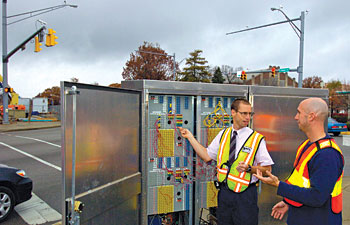City works with Purdue to create high-tech traffic-control system
The system is one of the first deployments in the country of new traffic signal management techniques developed at Purdue, says Darcy Bullock, a professor of civil engineering and director of the Joint Transportation Research Program. It allows engineers to attack traffic jams on two fronts: Determine more precisely how to adjust the length of green signals to better match traffic volumes and synchronize signals in series on busy roads so that motorists catch green lights in sequence.
"We have all been at intersections where the green light did not last long enough for all the traffic to pass through and then seen drivers on the opposing side of the intersection get too much green time," Bullock says. "What we are doing enables electronic signal controllers to collect data that can be used to effectively alter this timing to better manage traffic flow."

Darcy Bullock, from left, professor of civil engineering, and Edward J. Smaglik, a former postdoctoral research associate, discuss information provided by detection equipment at an "instrumented intersection." The engineers are using the system to test specialized detection and control software algorithms designed to help improve the safety and efficiency of traffic flow. (Purdue News Service photo/David Umberger)
The system improves signal-timing efficiency, says Lafayette City Engineer Jennifer Miller. "The ultimate goal is to allow the majority of the travelling public to spend less time stopped at a signal when it is red," she says. "Other potential benefits are improved fuel efficiency and reduced emissions because less time idling reduces fuel usage and the associated emissions. Having fewer starts and stops also reduces fuel consumption and emissions."
The system is integrated into portable signal controllers that are widely used at intersections across the country and uses specialized software algorithms. Data are displayed on a main computer in the city's traffic center, allowing personnel to monitor information and make a change to individual intersection timing.
"It is like a dashboard for signal systems," says Neal S. Carboneau, research manager of the Indiana Local Technical Assistance Program (LTAP) in the School of Civil Engineering. "You could equate it to the leap from horse-drawn carriages to commercial aircraft. In the past, you had to manually count vehicles and time their progression through the corridors. You would have to come back to the office and do calculations, then return to the signal to make adjustments to improve the flows. Then, in order to verify that the changes were effective you would need to go through the same procedure again. As you can imagine, it was a very inefficient and time-consuming process."
Recent advances in technology, including improvements to the reliability and speed of Internet access, as well as greater computer storage and processing ability, have made it practical to use computerized systems that operate signals.
Induction loops buried under pavement near signals indicate that a vehicle is in the turn lane and other locations. These loops, which are ubiquitous in U.S. cities, are connected to a computer in a cabinet at each intersection.
Algorithms in the system use mathematical equations and data from the loops and other sensors to determine whether an intersection's traffic volume is exceeding its capacity, tracking traffic during each cycle of green-amber-red. The resulting information is plotted on graphs that show how many vehicles are unable to get through an intersection before the signal turns red.
Such data enable the system to identify needed changes to signal timing to facilitate the flow of traffic and also to synchronize signals. "How often have you driven down a corridor and had it go green, green, green, green?" Bullock asks. The answer is, not very often. "The problem is that until now we have not had good measurement tools needed to create patterns of sequential green signals."
The system incorporates new traffic signal performance measures, criteria based on research on traffic flow that enable computers to decide how to optimize signal timing.
"We've married some theory with new data collection practices, performance measures and modern IT technology to come up with a better tool for making decisions about signal management," Bullock says.
The performance measures were developed with funding from the National Cooperative Highway Research Project and the Indiana Department of Transportation.
"The system has been installed and is operational, but since it is the first of its kind, getting it to be fully functional will take some time," says Fred Koning, foreman in the Lafayette Traffic Department.
Having a centralized system is helpful in troubleshooting the network, which is made up of numerous signals and computers and a web of electrical cables and sensors, Koning says.
City officials worked with LTAP to put the system in place. Carboneau says other states and local agencies across the country are modeling their system specifications based upon the system in Lafayette.
The project has involved about a dozen faculty, staff and students from engineering.
Officials in Elkhart County, Ind., assisted the research, and the county is in the process of bringing a similar system online.
City officials received a Merit Award for the new system from the American Council of Engineering Companies, which also recognized Bullock and Carboneau for their contributions.
Previous research has been funded by the Indiana Department of Transportation. A portion of that earlier work, on State Route 37 in Noblesville, Ind., yielded data indicating a potential 20 percent decrease in travel time for drivers. Findings from the Noblesville research show that optimizing signal timing has resulted in an estimated annual cost savings of $472,817, with a reduction in carbon dioxide emissions of 197 tons per year.
